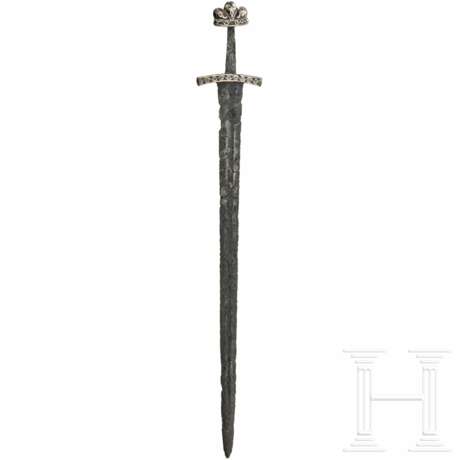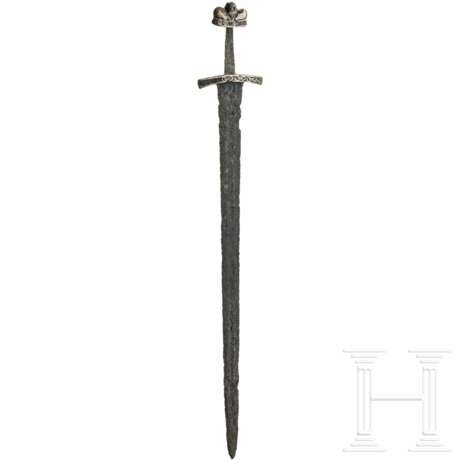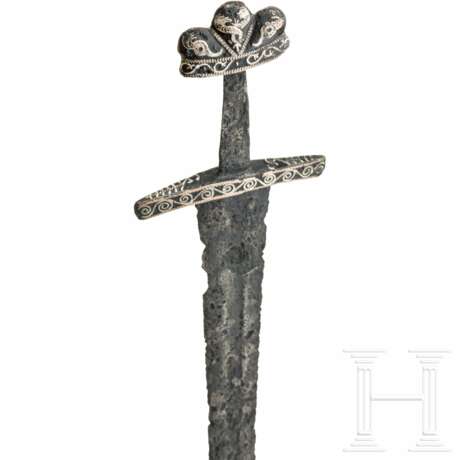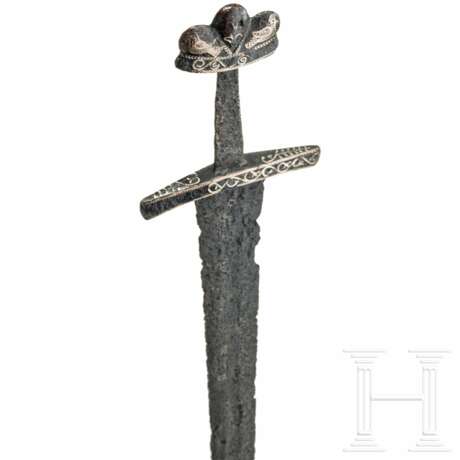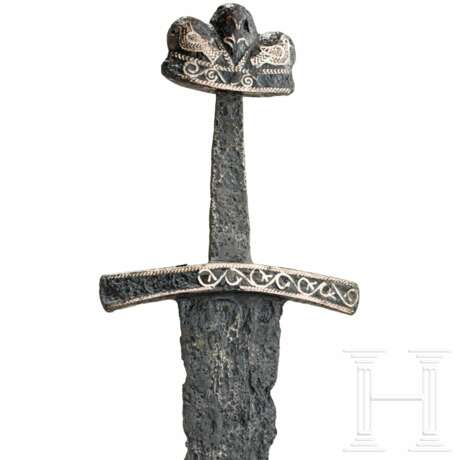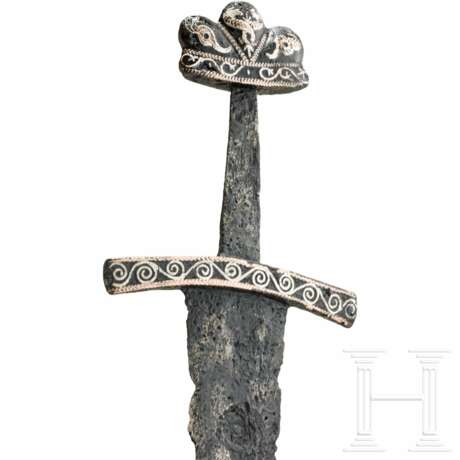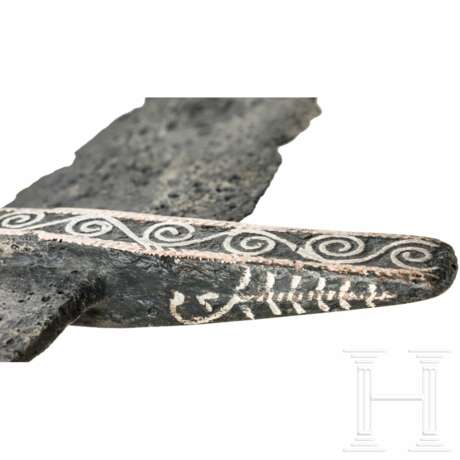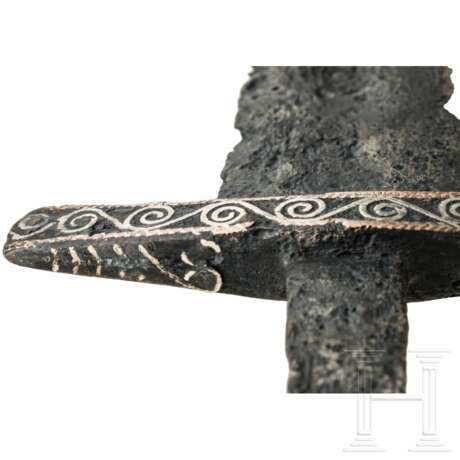Wikingerschwert mit Tauschierung im Ringerike-Stil, ausgehendes 10. - frühes 11. Jhdt.
06.05.2025 10:00UTC +01:00
Classic
Vendu
14000EUR € 14 000
| Auctioneer | Hermann Historica |
|---|---|
| Lieu de l'événement | Allemagne, Grasbrunn / München |
| Commission | 25 % |
Archive
La vente aux enchères est terminée. Vous ne pouvez plus enchérir.

ID 1416473
Lot 4121 | Wikingerschwert mit Tauschierung im Ringerike-Stil, ausgehendes 10. - frühes 11. Jhdt.
Wikingerschwert vom Typ Petersen "L" bzw. Wheeler "VI". 81 cm langes Klingenblatt, in der Mitte seichte, breite Hohlkehle, die sich von der Parierstange bis kurz vor die Spitze zieht. Die Klinge verjüngt sich von 5,5 cm Breite unterhalb der Parierstange auf ca. 2 cm unmittelbar vor der Spitze mit leicht eingezogenen Seiten. Oberhalb des Klingenansatzes die langtrapezoide Griffangel, auf der unten eine an den Seiten leicht nach unten gekrümmte Parierstange aus massivem Eisen mit Tauschierung aufgesteckt ist. Am oberen Ende der Griffangel ein Knauf mit seitlich leicht nach oben gebogener Basis und dreigliedrigem oberen Abschnitt, gleichfalls mit Tauschierung.
Die Tauschierung im Ringerike-Stil des frühen 11. Jahrhunderts: Die Parierstange beidseitig mit unterschiedlich gestalteten Wellenranken verziert, oben und unten begrenzt von einer Linie mit Fischgrätenmuster, dessen V-förmige, ineinandergeschobene Drahteinlagen alternierend aus Silber- und Kupferdraht gefertigt sind. Auf der Oberseite der Parierstange ein "tannenbaumartiges" Motiv mit Voluten an der Basis, ebenfalls zweifarbig aus Kupfer und Silber.
Der Dekor des Knaufes auf beiden Seiten verschieden. Auf einer im unteren Abschnitt Wellenranken mit Spiralen, begrenzt durch Linien mit Fischgrätenmuster, auf der anderen Seite eine Wellenranke mit an den Enden gegabelten Windungen. Die Kerben auf dem Oberteil des dreigliedrigen Knaufes auf beiden Seiten durch eine Linie mit Fischgrätenmuster markiert, wieder zweifarbig aus Kupfer und Silber. Auf den Höhen der gewölbten Knuppen auf beiden Seiten unterschiedliche, wiederum zweifarbige Tierdarstellungen. Auf einer Seite mittig zwei ineinander verschlungene Fabelwesen mit Drachenleibern und seitlich je ein einwärts gewandter Raubvogelkopf mit Halsansatz. Auf der anderen Seite mittig eine "Palmette", seitlich je zwei auswärts gerichtete Vögel.
Gesamtlänge 96,5 cm. Die Oberfläche mit Rostnarben, an den Kanten meist nur minimale Scharten, zwei größere auf einer Seite knapp unterhalb der Parierstange. Ansonsten fachmännisch restauriertes und stabilisiertes Schwert mit guter Eisensubstanz ohne jede Ergänzung.
Ein selten schönes Exemplar eines Wikingerschwertes, das sich durch einen ausgefeilten, einzigartigen Dekor auszeichnet.
Provenienz: Süddeutscher Privatbesitz (nachgelassen), übernommen aus einer Spezialsammlung mit Schwerpunkt auf Stichwaffen, erworben in den 1960er bis 1970er Jahren im Kunsthandel.
A Viking sword with Ringerike-style inlay, late 10th – early 11th century A.D.
A Viking sword with Ringerike-style inlay, late 10th – early 11th century A.D.
Viking sword of the Petersen ‘L’ or Wheeler ‘VI’ type. 81 cm long blade, with a shallow, wide fuller in the centre extending from the crossguard to just before the point. The blade tapers from a width of 5.5 cm below the crossguard to approx. 2 cm directly in front of the point with slightly indented sides. Above the base of the blade is the long trapezoid tang, on which a crossguard of solid iron with wire inlay work is attached, curved slightly downwards at the sides. At the upper end of the tang a pommel with a slightly upward curved base and a tripartite upper section, also wire inlaid.
The inlay in the Ringerike style of the early 11th century: the crossguard decorated on both sides with differently shaped wavy tendrils, bordered at the top and bottom by a line with a herringbone pattern whose v-shaped, interlocking wire inlays are made of alternating silver and copper wire. On the top of the crossguard a ‘fir tree’ motif with volutes at the base, also in two colours of copper and silver.
The decoration of the pommel is different on both sides. On the lower section of one side wavy tendrils with spirals, bordered by lines with a herringbone pattern, on the other side a wavy tendril with forked coils at the ends. The notches on the upper part of the tripartite pommel are marked on both sides by a line with a herringbone pattern, again in two colours of copper and silver. Different, again two-coloured animal depictions on the heights of the domed knobs on both sides. On one side in the centre two intertwined mythical creatures with dragon bodies and on each side an inward-facing bird of prey head with neck attachment. A ‘palmette’ in the centre of the other side, with two outward-facing birds on each side.
Total length 96.5 cm. The surface with rust pitting, mostly only minimal nicks on the edges, two larger ones on one side just below the crossguard. Otherwise a professionally restored and stabilised sword with good iron substance without any additions.
A rare, beautiful example of a Viking sword, characterised by its sophisticated, unique decoration.
Provenance: Private South German collection (bequeathed), inherited from a special collection with a focus on edged weapons, acquired in the art trade during the 1960s to 1970s.
Condition: II -
| Catégorie maison de vente aux enchères: | Moyen Âge et temps modernes |
|---|
| Catégorie maison de vente aux enchères: | Moyen Âge et temps modernes |
|---|
| Adresse de l'enchère |
Hermann Historica Bretonischer Ring 3 85630 Grasbrunn / München Allemagne | ||||||||||||||
|---|---|---|---|---|---|---|---|---|---|---|---|---|---|---|---|
| Aperçu | |||||||||||||||
| Téléphone | +49 (0)89 5472 649 0 | ||||||||||||||
| Fax | +49 (0)89 5472 64999 | ||||||||||||||
| Commission | 25 % | ||||||||||||||
| Conditions d'utilisation | Conditions d'utilisation | ||||||||||||||
| Heures d'ouverture | Heures d'ouverture
|
